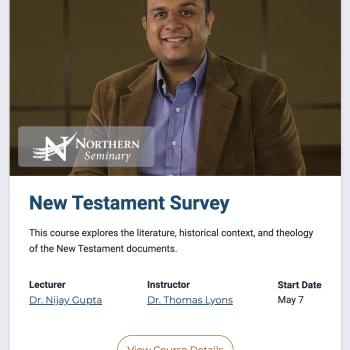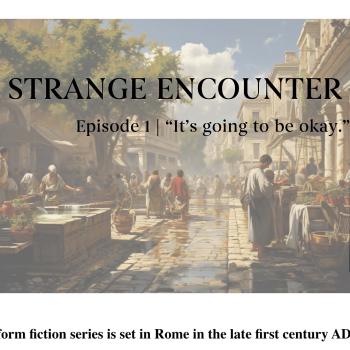
Imagine that you, a preaching pastor, made a plan to preach through the Sermon on the Mount for six weeks. That plan sounded great a year ago when you set up the preaching calendar. But now that the series is a week away from beginning, you scramble to pick up “resources” for studying this important and complex portion of Scripture. So you are a bit panicked.
 Now, imagine, in the midst of your panic, you hear your computer “bleep” informing you that you have a new email. You discover that Scot McKnight has sent you an email out of the blue: “Dear pastor [your name]: I heard you are preaching and teaching on the Sermon on the Mount. I’d love to be available to consult with you and answer any questions. Call me whenever you need.” What relief! Someone to guide you through!
Now, imagine, in the midst of your panic, you hear your computer “bleep” informing you that you have a new email. You discover that Scot McKnight has sent you an email out of the blue: “Dear pastor [your name]: I heard you are preaching and teaching on the Sermon on the Mount. I’d love to be available to consult with you and answer any questions. Call me whenever you need.” What relief! Someone to guide you through!
OK, that’s not going to happen.
But there is good news. Scot McKnight’s new Sermon on the Mount (Story of God) commentary is nearly the same thing. What sets this commentary apart from other resources is that (1) It is focused solely on the Sermon on the Mount (SotM), (2) It is very accessible and conversational in style, (3) and McKnight tackles every important exegesis, theological, and “application-related” issue you could imagine. Its the next best thing to a direct line to McKnight!
Confession: I thankfully received this commentary from my “Z” friends and I had no intention of reading it cover-to-cover because commentaries are typically exhausting. To my surprise, I couldn’t put the book down! From the great hermeneutical discussions, to choice quotes from other scholars, to touching personal and anecdotal stories, it is undoubtedly a resource I will turn to often.
Here are some quick details:
This is a new commentary series that is aimed at exposition and application. This all happens through the “Story of God” hermeneutics – the idea that Scripture tells a story of redemption and the story itself is formative for faith, yesterday, today, and tomorrow. When a Biblical passage is discussed, the commentary writer (here McKnight) offers three sections: Listen to the story (introduction/overview; themes), Explain the story (exegesis), Live the story (application, engagement with the modern world & everyday life).
While the series will have a Matthew volume (Rodney Reeves), McKnight launches the series with 280+ pages on the SotM. Given McKnight’s own wide-ranging interests and expertise (esp in hermeneutics and Biblical theology), this offers a nice introduction to the series as a whole.
McKnight’s own introduction to the SotM is outstanding, especially where he lays out his understanding of what it is and what it is trying to teach. I planned on summarizing the introduction here, but thankfully Jeremy Bouma has already done that. Needless to say, it is memorable and a helpful approach.
In a separate blog post, I may get into details of McKnight’s approach to specific passages, but right now my interest is a sweeping perspective. Here are four distinguishing characteristics of this commentary.
Well-Researched. It should go without saying that this is how McKnight operates, but it was clear to me that McKnight has read broadly and deeply in SotM scholarship, both in the modern and pre-modern periods. Especially we see interaction with Dale Allison (and Davies, ICC), Bonhoeffer, Calvin, Guelich, Keener, Pinchas Lapide, Luther, Stott, Talbert, Dallas Willard, and, last but not least, Tom Wright.
McKnight-ian. By this I mean that this commentary draws from McKnight’s strengths and the fruit of a lifetime of research on Jesus and Biblical theology. You will see, especially, regular reference to and consonance with The Jesus Creed, The Blue Parakeet, and The King Jesus Gospel.
Stories. The personal stories and anecdotes make this book more than a commentary. I have ear-marked several pages in the book and I have/will store them away as great applications for preaching and teaching (see esp. “Mugged by Jesus”, 135-138).
Let Jesus be Jesus. Many interpreters of the SotM don’t want to take Jesus’ commands too directly, either ethically or soteriologically. McKnight wants to let Jesus be Jesus – he does not paint the commands here as “optional” or “give it your best shot” for those who will be saved by grace through faith confessed. McKnight does want folks to read the SotM through the Story of God in Scripture, but that does not take away the radical edge of Jesus’ commands to obedience (McKnight is quite open about his anabaptist leanings!).
Prayer. Given the centrality and importance of the Lord’s prayer, and other elements of prayer in the SotM, I wanted to mention the focus on prayer in McKnight’s commentary and how much I appreciate his frankness (he doesn’t know why God doesn’t answer prayers sometimes) and his theological perspective. His theological perspective is worth repeating:
…God’s overall plan is established and known to God while granting freedom within that plan (p. 188).
That means that, while God is in control and has a wider plan for his work of redemption, “God genuinely interacts with humans who pray in such a way that the universe changes as a result of our prayers” (247). He cites T. Tiessen, Providence and Prayer: How Does God Work in Our World? (IVP, 2000).
Concerns?
I did not have any major concerns with this commentary. The strengths are evident and we are fortunate to benefit from the decades of research and teaching that are behind this work. If there is one weakness to this volume, in my humble opinion, it is that no serious attention or space is given to contextualizing the SotM within Matthew and as a part of Matthew’s own theology that begins with the genealogy/birth narrative/baptism/temptation, goes on to teachings and healings, continues into conflict, and culminates in the death, resurrection, and “Great Commission.” Don’t get me wrong, McKnight does appeal to various parts of Matthew throughout the commentary, but not in an intentional (Gospel-narrative) sort of way. Indeed, the passion narrative of Matthew is rarely discussed. In Dale Allison’s The Sermon on the Mount (1999), setting the SotM within Matthew’s story and theology is paramount: “Any credible interpretation of Matthew 5-7 must constantly keep an eye on Matthew 1-4 and Matthew 9-28” (Allison, xi). Now, I don’t think McKnight completely fails in this area (see the Scripture index), but I will say I had hoped for more, especially in the introduction.
Final Word
If and when a student or pastor tells me he or she is preaching on or studying the SotM, I won’t hesitate to recommend this book to them – my first recommendation. This launch volume should convince interested readers that the series is set on a good trajectory, and, if other volumes follow this model, I imagine I will have a lot of little red, blue, and green commentaries brightening up my bookshelves!











